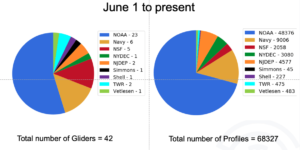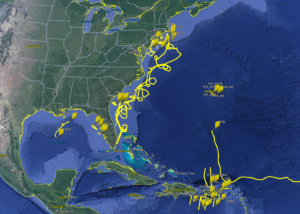-
Navy Gliders View the Cold Pool
Posted on October 25th, 2019 No commentsTwo Navy gliders were deployed in the Middle Atlantic Bight (MAB) between September 11 & 26, 2019. Their cross-shore trajectories were planned to capture the cold pool, a cold bottom layer of water that characterizes the MAB at this time of the year. There transects are shown below.

In the figures below, the top figure shows the cross-shore temperature transect for glider ng618. In this figure the cold pool can be identified as the bottom water with temperature less than 10 degrees Celsius. The cold pool has important implications for the fisheries of the region and it can become a “fire extinguisher” for tropical cyclones by lowering the sea surface temperature through vertical mixing during the passage of a storm.
The bottom figure shows the same ng618 glider trajectory from the Global Ocean Forecasting System (GOFS 3.1) that is a global operational ocean model run by the US Navy. The comparison between glider observations and the GOFS model are remarkably good.
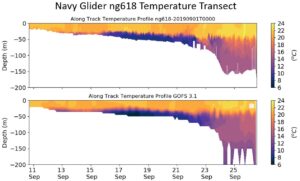
-
RUCOOL Updates August-September 2019
Posted on October 18th, 2019 No commentsField Campaign & Science Updates
State
- Joseph Brodie served as a panelist at the third annual Time for Turbines Offshore Wind Conference, hosted by the Business Network for Offshore Wind and Jersey Renews. The panel addressed environmental concerns around offshore wind development, and included NJDEP Deputy Commissioner Debbie Mans as a panelist.
- The RV Rutgers completed 12 cruises supporting 105 passengers. In addition to the cruises supporting DMCS research and glider deployments, these voyages included multiple undergrad classes that received training on plankton tows, water sampling/filtration, oxygen and chlorophyll measurements, and bacteria sampling.
- The first fall semester of the new Master’s program in Integrated Ocean Observing is well underway. Students are engaged in the principles of ocean measurement, building their own sensors from scratch, and are getting hands-on experience with real-world operations with the COOL group including glider deployments, rescue planning, and side scan sonar observations
- Masters students have and will continue to participate in national Marine Technology conferences and career networking events this fall.
National
- The RUCOOL Glider team was involved with five deployments in August and September. These deployments include work supporting NJDEP water quality research along the NJ coast, NASA research off of central California to validate a new sea surface height satellite, and NOAA and privately funded investigations of hurricane interactions with the ocean surface in the Mid-Atlantic Bight and Caribbean.
- RUCOOL deployed two Navy gliders in partnership with the Navy, NOAA OAR, MARACOOS and Monmouth University. Within two weeks, both gliders called into the Navy pilots, indicating that there were leaks. RUCOOL scrambled vessels from NorthStar Marine to recover these gliders at 3am on Sunday, September 22, and at 2am on Sunday, September 29. Both were recovered approximately 100 nautical miles from shore, within 48 hours of the first notification of a problem. If not for the round-the-clock efforts of RUCOOL, these navy gliders would have been lost as the leaks were severe in both cases.
- DMCS completed its work with the NSF funded REU program, RIOS. Students worked with mentors over a 10 week program that supported their research and provided weekly workshops that developed their career and research aptitude. The program was coordinated by Josh Kohut, and additionally 3 other RUCOOL scientists directly mentored students, and two RUCOOL scientists supported the RIOS career workshop. The summer program concluded in August with a science symposium in which the students shared their work and celebrated their research success.
- RUCOOL hosted our fourth OOI Ocean Data Lab Professional Development Workshopin August at Western Washington University. Fifteen faculty from community colleges, primarily undergraduate institutions, and universities from Washington, Alaska, California, Oregon, Ohio, Pennsylvania, and New York joined us. Teachers learned how to use and develop their own educational resources from real-time an archived OOI data that they can take back to their classrooms reaching students who may not otherwise have any experience in ocean science. Workshop information is at the Data Labs Workshops
- Grace Saba presented an invited talk at the Ocean Acidification Alliance meeting: Coast to Coast State Convening Regional Impacts of Ocean and Coastal Acidification and State-Led Efforts to Respond in Brooklyn, NY. As co-coordinator of the Mid-Atlantic Coastal Acidification Network, she will be involved in working toward ocean acidification action plans for Mid-Atlantic states, including New Jersey.
International
- Oscar Schofield lead the Principal Investigator meeting for the Palmer Long Term Ecosystem Research Program. This international program’s leadership is being transferred to Rutgers in Fall 2019.
- RUCOOL attended the decadal OceanObs19 meeting in Honolulu. The OceanObs’19 conference was a community-driven conference that brings people from all over the planet together to communicate the decadal progress of ocean observing networks and to chart innovative solutions to society’s growing needs for ocean information. White papers, many of which were co-authored by RUCOOL, are available here: http://www.oceanobs19.net/community-white-papers/.
- Oscar Schofield attended and presented at the Global Ocean Observing System General Regional Associations in Tokyo (August 5th– 8th 2019). He was representing the growing Southern Ocean Observing System.
Faculty Awards
- The Marine Technology Society made Josh Kohut an MTS Fellow based on outstanding contributions to the advancement of the Society’s objectives and who have distinguished themselves in their fields.
Papers Published: (**Current or Former Graduate Student or Postdoctoral Researchers)
- Filipa Carvalho**, Jessica N. Fitzsimmons, Nicole Couto**, Nicole Waite, Maxim Gorbunov, Josh Kohut, Matthew J. Oliver**, Robert M. Sherrell, Oscar Schofield. 2019. Testing the Canyon Hypothesis: Evaluating light and nutrient controls of phytoplankton growth in penguin foraging hotspots along the West Antarctic Peninsula. Limnology and Oceanography: 00, 1-16. DOI:10.1002/1no.11313Slesinger,
- Cristina L. Archer, Joseph F. Brodie, and Sara A. Rauscher. Global warming will aggravate ozone pollution in the U.S. Mid-Atlantic. Journal of Applied Meteorology and Climatology, 58:1267–1278, 2019. DOI: 10.1175/JAMC-D-18-0263.1.
RUCOOL Meetings & Conferences
Third Annual Time for Turbines Offshore Wind conference, Atlantic City, NJ; OceanObs19, Honolulu, Hawaii; Ocean Acidification Alliance, Brooklyn, NY; 4DVar Workshop, College Park, MD; Offshore Wind Big Data Workshop, Boston, MA; GOOS Meeting, Tokyo; OOI Data Lab Workshop, Bellingham, WA; LTER Planning Meeting; SWARM Science Workshop, Rutgers.
-
Low Surface Salinity During Tropical Storm Karen
Posted on October 3rd, 2019 No commentsDuring Tropical Storm Karen, there were 10 gliders deployed in the Caribbean (below). On Sep 24, the eye Karen passed over Navy glider NG278, just south of St. Croix.
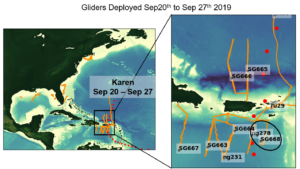
There is a good agreement in the vertical structure of temperature between GOFS 3.1 and the glider temperature (below).
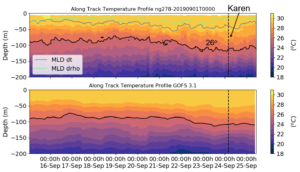
The GOFS 3.1 model, however, has a surface fresh layer (barrier layer) that is not as sharp as the observations show. This barrier layer gets even fresher and shallower during Karen (below). At the moment we are investigating if this freshening can be attributed to increased precipitation during the storm. If this is the case, this can be a mechanism that reinforces stratification during a storm and inhibits vertical mixing. We would like to investigate how important this possible mechanism is in controlling the storm intensity.
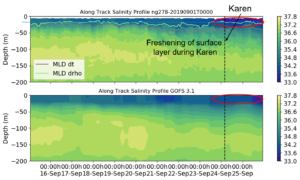
The freshening that happened during Karen (Sep 23 – Sep 24) is not initially captured by any of the models (below).
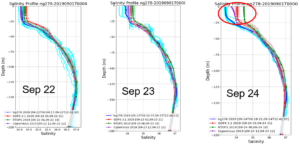
By Sep 26, the surface salinity in GOFS and Copernicus were much closer to the observations (both models assimilate data) but RTOFS still lags behind (below).

Images of these daily comparisons, since the inception of the 2019 hurricane season, are available here.
-
There are a lot of gliders out there!
Posted on October 1st, 2019 No commentsThe 2019 hurricane season is in full swing in the Atlantic Ocean. Since the inception of the hurricane season on June 1, 42 ocean gliders have been deployed in the western Atlantic ocean by numerous academic, corporate and government partners. These gliders have acquired over 68,000 profiles of temperature and salinity to date. Some gliders also record data on water optics, oxygen, current speeds, pH, and wave heights. A distribution of the groups funding the deployments is shown below as well as a map of their locations.
